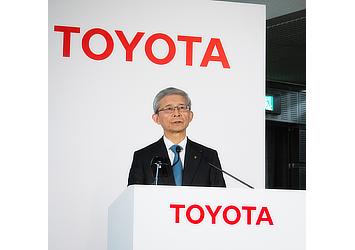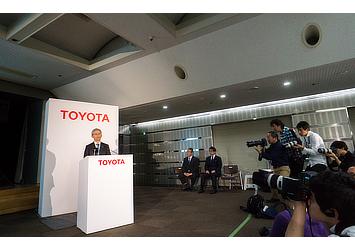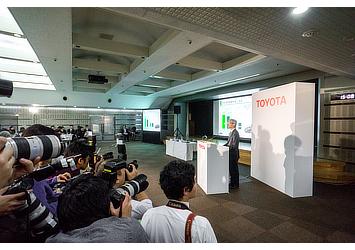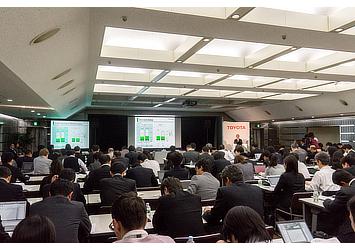Nov. 05, 2014
TMC Announces April-September 2014 Financial Results
(All consolidated financial information has been prepared in accordance with
U.S. generally accepted accounting principles)
Toyota City, Japan, November 5, 2014—Toyota Motor Corporation (TMC) today announced its financial results for the six-month period ended September 30, 2014.
Consolidated vehicle sales totaled 4,476,522 units, an increase of 8,761 units compared to the same period last fiscal year. On a consolidated basis, net revenues for the period totaled 12.94 trillion yen, an increase of 3.3 percent. Operating income increased from 1.2554 trillion yen to 1.3519 trillion yen, while income before income taxes1 was 1.5091 trillion yen. Net income2 increased from 1.0006 trillion yen to 1.1268 trillion yen.
Operating income increased by 96.4 billion yen. Major factors contributing to the increase included cost reduction efforts of 120.0 billion yen and currency fluctuations of 70.0 billion yen.
Commenting on the results, TMC Executive Vice President Nobuyori Kodaira said: “In addition to cost reduction efforts and favourable foreign exchange rates, valuation gains and losses mainly from interest-rate swaps were positive factors. However, changes in model mix and increases in expenses had a negative impact. ”
In Japan, vehicle sales totaled 1,030,229 units, a decrease of 70,977 units. Operating income decreased by 111.2 billion yen to 718.7 billion yen.
In North America, vehicle sales totaled 1,395,105 units, an increase of 97,061 units. Operating income, excluding the impact of valuation gains/losses from interest rate swaps, increased by 103.5 billion yen to 289.1 billion yen.
In Europe, vehicle sales totaled 414,217 units, an increase of 7,283 units, while operating income increased by 7.7 billion yen to 33.2 billion yen.
In Asia, vehicle sales totaled 754,818 units, a decrease of 24,768 units, while operating income increased by 17.2 billion yen to 212.9 billion yen.
In other regions (including Central and South America, Oceania, Africa and the Middle East), vehicle sales totaled 882,153 units, an increase of 162 units, while operating income increased by 1.8 billion yen to 77.9 billion yen.
Financial services operating income increased by 51.2 billion yen to 184.5 billion yen, including a gain of 21.2 billion yen in valuation gains/losses from interest rate swaps. Excluding valuation gains/losses, operating income increased by 0.6 billion yen to 163.2 billion yen.
For the fiscal year ending March 31, 2015, TMC revised its consolidated vehicles sales forecast from 9.1 million units to 9.05 million units, in consideration of the latest sales trends in each region.
TMC also revised its consolidated financial forecasts to consolidated net revenue of 26.5 trillion yen, operating income of 2.5 trillion yen, income before income taxes of 2.7 trillion yen and net income of 2.0 trillion yen, based on an exchange rate assumption of 104 yen to the U.S. dollar and 137 yen to the euro.
Commenting on the forecasts for the fiscal year ending March 31, 2015, Kodaira said: “We are revising our operating income forecast upwards by 200 billion yen to 2.5 trillion yen. This reflects the progress in our profit improvement activities through marketing and cost reduction efforts, the change in our foreign exchange rates assumption, along with a decrease in vehicle sales and an increase in fixed costs, particularly R&D expenses. ”
1Income before income taxes and equity in earnings of affiliated companies
2Net income attributable to Toyota Motor Corporation
(Please see attached information for details on financial results. Further information is also available at www.toyota-global.com)
Cautionary Statement with Respect to Forward-Looking Statements
This release contains forward-looking statements that reflect Toyota's plans and expectations. These forward-looking statements are not guarantees of future performance and involve known and unknown risks, uncertainties and other factors that may cause Toyota's actual results, performance, achievements or financial position to be materially different from any future results, performance, achievements or financial position expressed or implied by these forward-looking statements. These factors include, but are not limited to: (i) changes in economic conditions, market demand, and the competitive environment affecting, the automotive markets in Japan, North America, Europe, Asia and other markets in which Toyota operates; (ii) fluctuations in currency exchange rates, particularly with respect to the value of the Japanese yen, the U.S. dollar, the euro, the Australian dollar, the Russian ruble, the Canadian dollar and the British pound, and interest rates fluctuations; (iii) changes in funding environment in financial markets and increased competition in the financial services industry; (iv) Toyota’s ability to market and distribute effectively; (v) Toyota’s ability to realize production efficiencies and to implement capital expenditures at the levels and times planned by management; (vi) changes in the laws, regulations and government policies in the markets in which Toyota operates that affect Toyota’s automotive operations, particularly laws, regulations and government policies relating to vehicle safety including remedial measures such as recalls, trade, environmental protection, vehicle emissions and vehicle fuel economy, as well as changes in laws, regulations and government policies that affect Toyota’s other operations, including the outcome of current and future litigation and other legal proceedings, government proceedings and investigations; (vii) political and economic instability in the markets in which Toyota operates; (viii) Toyota’s ability to timely develop and achieve market acceptance of new products that meet customer demand; (ix) any damage to Toyota’s brand image; (x) Toyota’s reliance on various suppliers for the provision of supplies; (xi) increases in prices of raw materials; (xii) Toyota’s reliance on various digital and information technologies; (xiii) fuel shortages or interruptions in electricity, transportation systems, labor strikes, work stoppages or other interruptions to, or difficulties in, the employment of labor in the major markets where Toyota purchases materials, components and supplies for the production of its products or where its products are produced, distributed or sold; and (xiv) the impact of natural calamities including the negative effect on Toyota’s vehicle production and sales.
A discussion of these and other factors which may affect Toyota's actual results, performance, achievements or financial position is contained in Toyota's annual report on Form 20-F, which is on file with the United States Securities and Exchange Commission.





_W355_H250.jpg)





